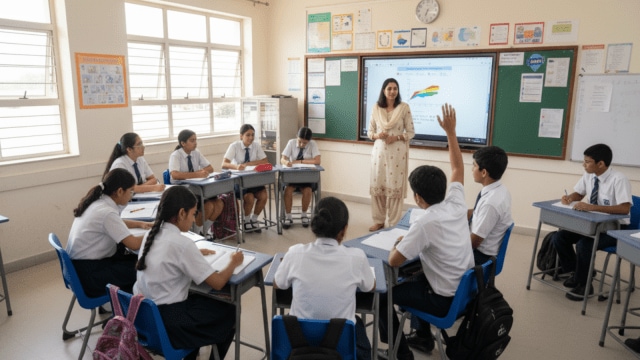Rise in schools under IB, Cambridge: Why Indian parents are turning to international boards
Speaking to students, parents as well as school-heads from prominent international-curriculum schools, we learnt that beyond mere academics and pedagogy there lies a larger priority among students and their parents for an education that is relevant internationally.
 Despite affordability being a concern, students and parents alike are choosing international curriculum for level of teaching, pedagogy and international opportunities (Representational Image/AI Generated via Gemini)
Despite affordability being a concern, students and parents alike are choosing international curriculum for level of teaching, pedagogy and international opportunities (Representational Image/AI Generated via Gemini)Cambridge Assessment International Education (CAIE), the education board behind ‘Cambridge’ for ‘IGCSE’ curriculum schools, recently announced that it has surpassed 1,000 schools in South Asia, with over 800 of those schools in India alone.
Similarly, data shared by the International Baccalaureate Organisation, the education board behind ‘IB’ schools, showed a 40 per cent growth from 183 schools in 2019 to over 255 schools in 2025. The latest entrant, apart from these two, has been the Western Australian Certificate of Education (WACE), an Australian curriculum, which plans to set up at least a hundred schools in the next three years, according to the WACE board.
The data highlights not just a shift in the choice of schooling but also a transformation in the priorities of Indian families. Both parents and students are seeking opportunities and learning approaches that traditional Indian school boards often fail to provide. This trend aligns with the National Education Policy (NEP)’s emphasis on internationalisation and flexible, skills-driven learning across all levels of education. The recent entry of several foreign universities establishing local campuses in India further reinforces this shift.
 Year-on-year growth of different international education boards in India (Data via respective education boards)
Year-on-year growth of different international education boards in India (Data via respective education boards)
How big has the growth really been?
The numbers speak for themselves: between 2019 and 2025, IB schools in India nearly doubled — from 183 to over 255. Cambridge schools grew even faster, jumping from 461 in 2019-20 to over 800 by 2024-25.
What’s more telling is where this growth is happening. It’s no longer just big cities driving the demand. Nearly half of all Cambridge schools — 47% to be precise, are now in smaller cities and towns, as per the board, implying that international boards are clearly finding takers beyond metros, to tier-2, tier-3 locations.
The newest player, WACE (an Australian curriculum), entered India only this year, receiving forma go-ahead from the Ministry of Education around May 2025, and is already planning to open 100 schools over the next three years.
ALSO READ | Amid Trump admin’s higher-ed squeeze, Modi govt plans scheme to woo back Indian-origin ‘star faculty’ abroad
Speaking to students, parents as well as school-heads from prominent international-curriculum schools, Indianexpress.com found, that beyond mere academics and pedagogy there lies a larger priority among students and their parents for an education that is relevant internationally — for those planning to pursue higher education abroad, while at the same time keeping them eligible and in tune with requirements for domestic higher education opportunities such as national level entrance tests (CUET, NEET, JEE, CLAT and other exams) — so they don’t miss out on any opportunity.
Why are parents, students turning to these curricula?
According to the Boards, international curricula emphasise conceptual learning, inquiry-based study, and critical thinking. Speaking to Indianexpress.com, Mahesh Balakrishnan, Senior Development Manager, India and Nepal said, “The IB focuses on building research, writing, critical thinking, and self-management skills that help students adapt confidently to new academic and cultural settings.”
This is in contrast to the rote-learning driven school systems that have traditionally dominated Indian classrooms. “We wanted our child to move beyond merely learning their lessons, and focus on real-world skills. We think the IB system encourages curiosity, not unnecessary competition,” shared a parent whose child is enrolled in an IB school in Gurgaon.
Globally, IB graduates are recognised by over 5,000 universities across 100+ countries, often offering credits or scholarships.
Similarly, apart from the aspect of curriculum, another drawing point for parents and students is the ‘global recognition’ of qualifications, which IB, Cambridge, or WACE offers. This typically allows students to apply to foreign universities without additional exams or equivalency requirements, for those recognising these curriculum.
Explaining the prospects of international acceptance, Vinay Sharma, Senior VP of International Education at Cambridge University Press & Assessment in South Asia, shared that Cambridge qualifications opens opportunities in more than 2,350 universities in over 90 countries which formally recognise Cambridge qualifications, including all UK universities and over 1,000 US universities.
He further added, “Many US universities also award credit for advanced courses, including Cambridge International AS & A Levels. This allows students to fast-track their college studies and graduate in less time.”
On similar lines, WACE, which plans to set up their first affiliated school, and begin intake-processes soon this year, shared that more than being a replacement to Indian style of teaching and curriculum, they are looking to enhance what is already taught.
Syed Sultan Ahmed, overseeing the rolling out of WACE in India said, “WACE builds strong academic foundations, especially in STEM, through application-based learning that strengthens both conceptual clarity and problem-solving skills. With equivalence granted by the Association of Indian Universities (AIU), WACE students can seamlessly appear for all national entrance exams, including JEE, NEET, CUET, and others.”
ALSO READ | 133 million girls still out of school across globe: UNESCO Report
Many parents, educators alike, also see these curriculum as aligned with NEP’s prescribed changes, which highlights flexibility, interdisciplinarity, and future-ready skills. Many parents say these curricula prepare students not only for exams that serve as entrances to higher education, but also for aspirations like studying abroad or going into unconventional fields beyond the traditional choices offered domestically.
Amity Global School Noida Principal, Anita Paul explained that a large number of students move to IB after Class 10 because of the wider subject choices it offers. IB focuses a lot on research and critical thinking through a subject called Theory of Knowledge (TOK). She said, “It prepares students well for higher education and the world of work. It’s no longer just about what you know, employers look for how you think and approach challenges.”
Speaking to a class 10 student at one of the Cambridge schools in Delhi-NCR, we learnt that priority among students remains more on what is being taught beyond textbooks, and how it keeps them at-par with peers internationally — meaning that if they secure an opportunity for a study abroad programme, they will be at a level playing field with others.
A class 10 student in an international school in Delhi-NCR, Priya* shared, “IGCSE and GCSE are quite similar, so when I go to study in the UK later, I’ll be on the same page as my classmates there. The focus of the study is more on what I’ve learned and how I can apply it in real-world situations.” She added, “This approach is more common abroad, whereas in India, the emphasis is often on exam-related chapters, which doesn’t always help with practical application.”
GCSE or General Certificate of Secondary Education is an academic qualification test taken by students in the UK. IGCSE is essentially a similar model but for international application.
How do these boards operate, and what sets them apart?
In the cases of IB and IGCSE, both offer school-authorities the flexibility to choose their own textbooks, teaching methods, as best determined by them.
The IB curriculum four programmes, from the Primary Years Programme to the Diploma and Career-related Programmes. According to the Board, the hallmark elements in their pedagogy is the Extended Essay, Theory of Knowledge, and Creativity-Activity-Service; these are aimed at encouraging research, reflection, and community engagement alongside academics.
Similarly, Cambridge schools, which have grown the fastest among the two, has nearly doubled its footprint in India in the last five years. Cambridge school curriculum runs from early years to A Levels.
In order to better understand beyond the similarities between the two Boards, what sets them apart, Indianexpress.com spoke to Rima Singh, Head of School at DPS International in Gurugram. She explains: “Cambridge is more structured and closer to CBSE because it offers a larger set of subjects and, although not mandatory, but a prescribed set of textbooks. IB on the other hand, includes elements like the Theory of Knowledge (TOK), the Extended Essay (a 4,000-word research paper), and Community Service (CAS).”
Another aspect she highlighted is the teacher-student ratio — something that lets students and teacher have a more in-depth curricular session while in schools. She shares, “Most IB schools maintain a maximum of 24–25 students per class. In primary years, we have two teachers for 24 students.”
International schools in tier 2, 3 cities: Are international schools still elitist?
As the Boards expand their footprint in India, affordability and accessibility remain recurring concerns among parents. According to the Board, India is one of the IB’s fastest-growing markets, registering a 30-fold rise in schools over the past 25 years, with presence now extending to tier 2 and tier 3 cities like Indore, Lucknow, and Coimbatore. “Parents are increasingly seeking inquiry-based, interdisciplinary learning, and schools are responding by offering support for Indian entrance exams alongside Cambridge’s skill-oriented approach,” said Paul.
The Cambridge International curriculum has also widened its presence beyond metros. According to data from the board shows that close to half of Cambridge schools in India are now located in tier 2 and tier 3 cities, spanning institutions from Dhirubhai International School in Mumbai to Avasara Academy in Pune and even a BMC-run school in Mumbai.
“One of the growing discussions among parents is around affordability — Cambridge schools vary widely in fee structures, making them more accessible than people assume,” said Rima Singh. Adding that to increase accessibility, the board’s new Cambridge Connect Bridge Course (2024) aims to address concerns from parents about gaps in preparation for JEE and NEET, helping students transition more smoothly to national-level exams.
The Western Australian Certificate of Education (WACE), introduced in India this year, is positioning itself as a more affordable alternative within the international curriculum space. In terms of affordability, Ahmed clarified, “As a government-backed programme, its operational costs are 30–40% lower than other international boards, making it viable for schools with limited resources.” He added, “The curriculum integrates Indian history, language, and culture while maintaining international benchmarks. Its ATAR ranking system ensures recognition across major global universities.”
Where are all the students going after their plus-two?
For the IB curriculum, the trend is gradually shifting toward Indian universities. More than 51% of Indian IB graduates now choose to stay in India for higher education, while the remaining students pursue studies abroad. The Association of Indian Universities (AIU) recognises the IB Diploma as equivalent to Grade 12 from CBSE or CISCE, ensuring eligibility for JEE, NEET, and other national entrance exams.
The Cambridge International board reports a balanced mix of destinations. According to its Destination Survey 2024, 56% of students continued their studies at Indian universities, while a significant proportion pursued global options — with 30% of schools noting increased numbers heading overseas.



- 01
- 02
- 03
- 04
- 05




























